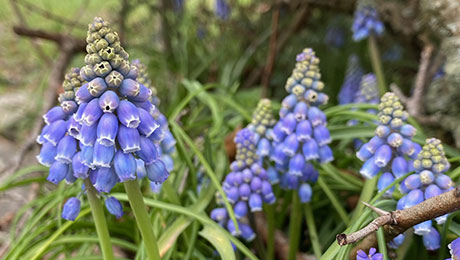
The term “bulb” has become a generic term for the assortment of “true” bulbs, corms, tubers, and even rhizomes we may plant in fall or spring. What I really mean to say when I say “bulb” is “geophyte.” A geophyte—geo- (“earth”) + -phyte (“plant”)—is a perennial plant that bears its buds below the surface of the soil. However, when we think about bulbs in fall, our mind most likely goes to the promise of an ephemeral flash of spring brilliance. Planting a variety of geophytes or bulbs in fall is an important way to embrace all that the plant world has to offer.

First, for those reading this who have not gardened in the South for very long, let me talk about tulips. Tulips (Tulipa spp. and cvs., Zones 3–8) are of course one of the most iconic fall-planted, spring-flowering bulbs. However, most of the tulips sold at big-box stores with beautiful pictures stapled to the front are not going to be long-lasting perennial plants in your garden. Public gardens around the South (and most everywhere for that matter) that have large spring tulip displays actually remove and discard their tulip bulbs right after their spring show is over. If you want a traditional tulip in the South, look for single late-blooming varieties and treat them like annuals. Or you could choose what are known as “species” tulips, which are better perennializers in our region. ‘Lady Jane’ tulip (Tulipa clusiana ‘Lady Jane’, Zones 3–8) is one such “species” tulip that has understated rosy outer petals opening to white centers. If planted in well-drained soils, this can be one of the few perennializing tulips in the South.

What I get excited about are different fall-planted geophytes that are long lasting in the garden—those that have a possibility of naturalizing and continuing on for generations to come. The bulb that sticks out to most Southern gardeners as long lasting and perennial is the daffodil (Narcissus spp. and cvs., Zones 3–9). It is not uncommon in the South to see daffodils in a line where an old sidewalk once was or marking the outline of a house’s foundation torn down long ago. To pick one of these long-lasting varieties, rely on local knowledge in your area to help you get it right. Fragrant and reliable, I’ve always liked an old and reliable variety of daffodil called ‘Thalia’ (Narcissus ‘Thalia’, Zones 3–9) that was registered in 1916.

There are dozens of lesser known fall-planted geophytes that should be considered for your garden. Some are small and may seem insignificant at first but can offer you flowering shows at unexpected times. The snowdrop (Galanthus spp. and cvs., Zones 3–9) is a great example, often blooming when winter still has a bit of a grip on our region. Others may be appropriately planted in the fall but do not display their glory until the following autumn. The red spider lily (Lycoris radiata, Zones 6–10) is a great example of just such a bulb.

Summer snowflake (Leucojum aestivum, Zones 4–8) is another lesser-known geophyte. In fact, it is a plant I’ve gotten more and more interested in over the last few years. It’s truly like a snowdrop on steroids. Clear white, pendulous bells with green tips stand above and among dark green, strappy foliage. I’ve been particularly impressed with its ability to withstand a variety of conditions, including the edges of a dry shade bed. The cultivar ‘Gravetye Giant’ is a robust selection that is slightly larger than the species.
There are many other lesser-known geophytes you can add to your landscape. When given the right conditions, bulbs (I mean geophytes) can be a carefree and joyful addition to any garden. Adding the right lesser-known geophyte to your landscape just might catch the eye of other gardeners. And who knows, this could lead to some of these lesser-known beauties becoming more common in our region.
—Andy Pulte is a faculty member in the plant sciences department at the University of Tennessee.
Fine Gardening Recommended Products

Johnny’s Selected Seeds Connecta® Cultivation Kit
Fine Gardening receives a commission for items purchased through links on this site, including Amazon Associates and other affiliate advertising programs.

The Nature of Oaks: The Rich Ecology of Our Most Essential Native Trees
Fine Gardening receives a commission for items purchased through links on this site, including Amazon Associates and other affiliate advertising programs.

Gardener's Supply Company Summerweight Fabric Plant Cover
Fine Gardening receives a commission for items purchased through links on this site, including Amazon Associates and other affiliate advertising programs.



















Comments
Log in or create an account to post a comment.
Sign up Log in